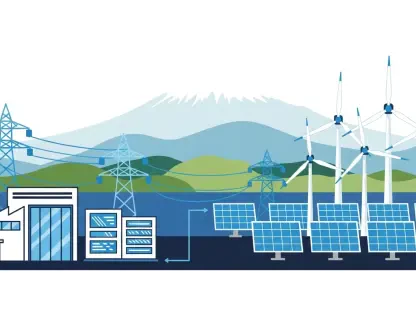As Texas gears up for the transformative Real-Time Co-optimization (RTC) initiative set to launch in December 2025, the state’s energy landscape is poised for significant enhancements in grid efficiency, reliability, and cost savings. This ambitious effort, led by the Electric Reliability Council of Texas (ERCOT), aims to revolutionize real-time dispatching of energy and ancillary services, integrating advanced battery storage solutions into the grid for maximum performance.
ERCOT’s real-time optimization of energy and ancillary services signifies a pivotal change in managing Texas’ electricity market, evolving from a system that primarily acquires ancillary services on the forward market with minimal real-time adjustments. This new approach aims to dynamically optimize real-time market operations, considering both energy demand and ancillary services simultaneously to lower costs by utilizing the most cost-effective resources first.
Revolutionizing Texas’ Energy Market
The RTC initiative symbolizes a significant upgrade in Texas’ electricity market, which has not seen such a substantial improvement since the nodal market design was introduced in 2010. Under this new system, ERCOT aims to enhance the market by integrating ancillary services into the real-time dispatching process, thus allowing for the efficient utilization of the least costly resources. Pablo Vegas, President and CEO of ERCOT, emphasized the importance of this implementation, describing it as the most significant market improvement in over a decade.
Significant financial investments underscore the extensive planning and resources required for this groundbreaking initiative. Initially estimated at $40 million in 2019, the project cost had risen to $50 million by 2023. Despite these rising costs, the foundational goal remains unchanged: to dynamically optimize the electricity market and create a more efficient, cost-effective grid. Real-time optimization aims to streamline operations and ensure that Texas can meet its growing energy demands more economically.
Addressing Urgent Needs and Challenges
The vital need for an efficient and reliable grid became glaringly evident during the February 2021 winter storm, which caused severe power outages and highlighted inadequacies in the existing system. Extreme weather events underscored the urgency for a robust solution capable of handling such crises. In response to these challenges, the RTC project timelines and scope were reassessed to better address the grid’s vulnerabilities.
While initially projected to be operational by 2023, the ERCOT initiative faced delays due to the winter storm’s consequences. Despite setbacks, the project’s core objective to create a dynamic, cost-efficient market remains steadfast. The enhancement is intended to bolster reliability, ensuring the grid can accommodate Texas’ expanding population and energy demands. This real-time optimization is seen as critical to mitigating the risks associated with extreme weather events and future-proofing the energy infrastructure.
Financial Impacts and Cost-Benefit Analysis
Operational efficiency through real-time optimization is expected to translate into significant financial savings, a fundamental aspect driving ERCOT’s initiative. A 2018 cost-benefit analysis by Potomac Economics, ERCOT’s independent market monitor, estimated that if RTC had been implemented in 2017, substantial annual savings would have been realized. These included projected savings of $1.6 billion in energy costs, $257 million in congestion costs, and $155 million in ancillary service costs.
Such projected savings highlight the immense economic benefits at stake, emphasizing why this initiative is crucial for both the market and Texas consumers. Keith Collins, Vice President of Commercial Operations at ERCOT, predicts annual savings exceeding $1 billion in the wholesale market. These financial benefits could lead to more stable electricity prices for consumers and reinforce the economic viability of advanced grid management.
Integrating Advanced Battery Storage
Battery storage, initially not part of the RTC project, has now been recognized as an essential component and is reflected in the rebranded RTC+B. The dramatic rise in battery capacity from 275 MW in 2020 to nearly 8.9 GW by August 2023 underscores the growing importance of integrating advanced battery storage solutions within the grid for optimal performance.
As ERCOT prepares for RTC+B, market trials scheduled between May and November 2025 aim to identify and resolve potential challenges before full-scale implementation. This integration is expected to bolster grid reliability and leverage the latest advancements in energy storage technology, ensuring the grid can handle real-time adjustments more efficiently. The benefits of these advancements are anticipated to be substantial, both in terms of reliability and financial savings, positioning ERCOT at the forefront of grid optimization efforts.
Learning from Global Energy Storage Trends
Texas is not alone in its pursuit of a more resilient energy system, as numerous global projects highlight the critical role of energy storage in improving grid efficiency and stability. For instance, the UK’s Balance Power’s 49.5 MW battery energy storage project in Hinckley and Scotland’s 228 MW facility by Kona Energy illustrate a growing consensus on the importance of energy storage in enhancing grid management.
These international projects highlight shared understanding and collaboration across borders, emphasizing the necessity of improved energy storage to ensure a stable and efficient power system. Texas’ initiative is well-aligned with these global trends, aiming for similar advancements that will support its unique grid management requirements and thereby make significant strides in grid modernization and resilience.
Technological Innovations and Strategic Partnerships
Technological advancements and strategic collaborations remain central to the success of energy storage projects globally. For example, Natron Energy’s $1.4 billion sodium-ion battery plant in North Carolina showcases the industry’s shift towards diverse and innovative storage solutions, reflecting the dynamic and evolving nature of energy storage technology.
Strategic partnerships play an equally critical role in driving large-scale initiatives. Malta Inc. and Schmid Pekintas, for instance, are collaborating to develop hybrid solar energy storage projects across multiple regions, demonstrating how partnerships can harness pooled expertise and resources to achieve significant technological advancements. These collaborations exemplify the global effort to enhance grid management by leveraging combined technological prowess and strategic insight.
Navigating Regulatory and Financial Frameworks
No large-scale initiative can succeed without a robust regulatory and financial framework to support it. Power companies in the U.S., for instance, face regulatory challenges while aligning with clean energy goals, as seen with EVLO’s battery storage project in Vermont. Additionally, substantial financial backing is essential for realizing these projects, illustrated by Aypa Power securing $323 million for Idaho’s largest battery storage project.
These regulatory and financial frameworks provide necessary support, ensuring projects like RTC+B have the clarity and resources they need to be successful. Texas’ real-time optimization initiative will similarly depend on strong regulatory structures and substantial financial investments to attain its full potential and thereby achieve a more efficient, reliable, and resilient grid.
The ERCOT initiative, combined with global advancements in energy storage, underscores a pivotal shift towards more efficient, reliable, and resilient energy systems. This comprehensive effort marks a significant stride toward the future, reflecting a unified understanding of the sector’s transformative potential. As Texas continues to innovate its energy infrastructure, it stands as a testament to forward-thinking grid management aligned with global best practices.









